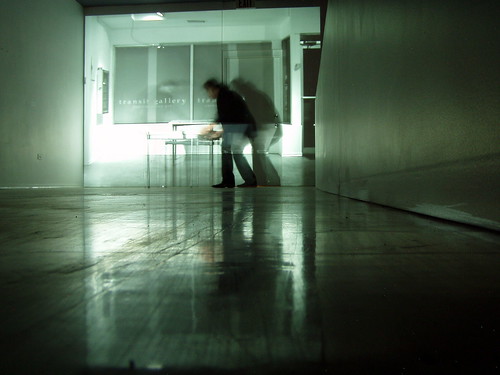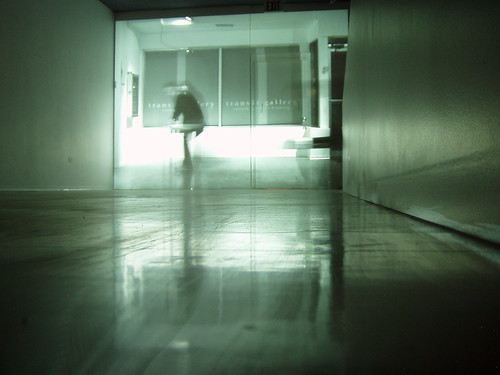Starting in darkness, digital video was projected onto the performance space. Tajber then began to manipulate folding chairs and wooden tables in front of the video. Precise movement was emphasized, with particular attention paid to circular patterns walking around the central table. Placing chairs and tables became a percussive motion, and the sound was recorded and manipulated accordingly, bringing the spectator out from their comtemplative nostalgia. Chairs where slammed open and shut, and every object was placed rather violently to emphasize the sound that was made, a continual reminder of the absolute presence of the artist and of course the work itself. The video was a further temporal dynamic. It consisted of several instances of the live performance viewed with a delay, so that it appeared to interact with the live performance.
Is viewer nostalgia the locus of this piece? "I remember when he did that", you might ask yourself upon witnessing video of Tajber's actions as you remember them from a few seconds or minutes prior in the performance. This memory game was quickly interrupted, as some of the video that was projected depicted actions which the "live" Tajber had not performed. Over the course of the performance it became increasingly tough to temporally localize movements and their resultant forms. The projected video played with this ever-so-important component of contemplation, and indeed of ego in relation to the I of thought. Events in the video both foretold and hypothesized events of the "live" performance, rendering all of Tajber's actions to be both portents and ghosts. Linearity was brought into question as the hypereal performance of the video began to suggest a muddy existence for any sense of material causality.
I continually found myself challenged by this piece to justify my own existence against the limitations of representation. By this, I mean to suggest a mutual dependence on representation as fundamental to consciousness itself. Is contemplation an able-ity to create space and form that is both tactile and material, as suggested by Tajber's cross-temporal table manipulations? Tables piled to create space in both material and hypereal planes literally support the weight of the artist himself, as he himself appears to sit in contemplation of the work in situ (although, this pose is not a satirical gesture to philosophical thought itself, nor to the sculpting tradition by referring to that famous thinking statue).
More importantly however, this piece serves to delineate an argument countering the agency of the viewing audience. We must never forget our own inaction when allowing art to be experienced, and perhaps Tajber seeks to indict the fascist tendencies in much of modern screened culture: the ability of the screen to wash over any sense of individual agency, to allow and to not question what is presented or the process by which it is experienced. All television advertisements, after all, are stylized performances which themselves question viewer agency by deconstructing their sense of identity and representing it back to them as frayed wires, exposed for manipulation. By and large, the viewing subject does not question this subjugation -- or seen in a more extreme light, this loss of identity to a beautiful and ever-occurring annihilation. Is it this fascism which stands between the modern subject as interpellated by contemporary culture -- the consumer of all that is visible, and indeed of visibility itself -- and a true post-modernity wherein subjects attempt to counter their inscription as consumers and assume a voice and sense of public agency that is more in line with their own interests rather than those of the (mostly corporate) producers of visual culture?
A final note: please forgive these images as I was without tripod and the light levels required an 8 second exposure; add the very limited amount of audience space, and thus frame content could not really be selected in any more or less controllable manner.


5 comments:
A phenominal interpretation of a phenominal performance, Q. You're right on the money with the past and future tense (tension?) of the interaction between the video and the live performance elements of the piece.
A phenominal interpretation of a phenominal performance, Q. You're right on the money with the past and future tense (tension?) of the interaction between the video and the live performance elements of the piece.
So phenominal in fact, I apparently had to say it twice.
You do a great service to recognize this artist's work. I participated in organizing his visit to Hamilton, and while the audience was small for the event, I believe they saw one of the best time-based artists working today. Thanks so much for your thoughtful comments, and the photos themselves are brilliant.
. . . and thanks to transit gallery, a private commercial gallery, for hosting such an important event.
Post a Comment